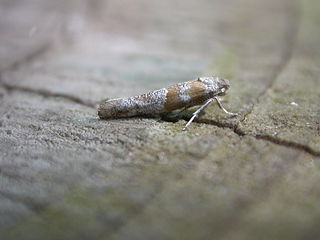
Yponomeutoidea is a superfamily of ermine moths and relatives. There are about 1,800 species of Yponomeutoids worldwide, most of them known to come from temperate regions. This superfamily is one of the earliest groups to evolve external feeding and to colonize herbs in addition to shrubs and trees.

The Plutellidae are a family of moths commonly known as the diamondback moths, named after the diamondback moth of European origin. It was once considered to have three subfamilies: Plutellinae, Praydinae, and Scythropiinae. Praydinae was later elevated to its own family, Praydidae, while Scythropiinae has variously been moved to Yponomeutidae or also elevated to its own family.

Ocnerostoma piniariella is a moth of the family Yponomeutidae. It is found in Europe. The species closely resembles Ocnerostoma friesei.

Cedestis gysseleniella is a moth of the family Yponomeutidae. It is found in Europe and parts of Russia.

Prays fraxinella, also known as the ash bud moth, is a moth of the family Plutellidae found in Europe. The larvae are leaf miners, feeding on the leaves and buds of ash trees.
Epactosaris is a genus of moths of the family Yponomeutidae.
Euarne is a genus of moths of the family Yponomeutidae. It is named after Euarne, one of Hesiod's 50 Nereids.

Prays is a genus of moths of the family Praydidae, formerly assigned to Plutellidae or Yponomeutidae.
Paraargyresthia is a genus of moths of the family Yponomeutidae.
Distagmos is a genus of moths of the family Plutellidae.

Argyresthiidae is a family of moths known as the shiny head-standing moths. It was previously treated as a subfamily of Yponomeutidae.
Prays liophaea is a species of moth in the family Praydidae. It was described by English entomologist Edward Meyrick in 1927 based on two specimens collected from Stellenbosch, South Africa.
Prays peperitis is a species of moth in the family Praydidae. It was described by English entomologist Edward Meyrick in 1907 based on seven specimens collected in Sri Lanka.
Prays xeroloxa is a species of moth in the family Praydidae. It was described by English entomologist Edward Meyrick in 1935 based on larvae collected from the island of Java and reared on Harrisonia leaves.

Praydidae is a family of false ermine moths in the superfamily Yponomeutoidea. Though once considered a subfamily (Praydinae), a 2013 molecular analysis elevated it to family rank.
Prays peregrina is a moth of the family Plutellidae. It was first discovered in North London in 2003, and subsequently in the Chelsea Physic Garden, West London in 2005. Since then there have been a number of records in the London and Kent area. Although it is only known from Great Britain, the species is thought to be native to Asia and was imported with food or plants from that region.
Prays omicron is a moth of the family Praydidae. It is found in Japan.
The Global Lepidoptera Names Index (LepIndex) is a searchable database maintained by the Department of Entomology at the Natural History Museum, London. It is based on card indices and scanned journals, nomenclatural catalogues and the Zoological Record. It contains most of world's Lepidoptera names published until 1981 and for some groups is up to date. As of May 2023, the site reads "Database last updated January 2018" so the current validity of the taxonomic combinations presented should be adopted with caution.







